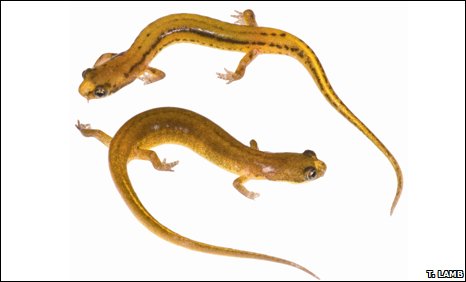| ||||||||||||||||||||||||||||||||||||||||||||||||||||||||||||||||||||||||||||||||||||||||||||||||||||||||
|
A striking new species of lungless salamander has been found living in a small stream in the Appalachian foothills of the US. 美国阿帕拉契山山麓丘陵地区的一条小溪里发现没有肺的引人注意的新蝾螈。 The salamander is so distinct(独特的,不同的) that it's been classified within its own genus(种,类), a taxonomic(分类学) grouping that usually includes a host of related species. The creature breathes through its skin, and unusually for its kind, males and females have different colouration. Such a distinct amphibian1(两栖动物) has not been found in the US for half a century. The researchers who discovered the salamander describe it in the Journal of Zoology2. They have dubbed3(复制,授予称号) it the 'patch-nosed' salamander after the yellow patch on the animal's snout(鼻口部). The tiny animal averages just 25 to 26mm long. They found so few of the animals that either it is highly secretive, or more likely it survives in such small, isolated4 numbers that it is already at risk of extinction5. "This animal is really a spectacular find," says biologist Carlos Camp of Piedmont College in Demorest, Georgia, who led the team which described the new species. "It is the first genus of amphibian, indeed of any four-footed vertebrate(脊椎动物), discovered in the US in nearly 50 years." Around the world, there are approximately 500 species of salamander. Two-thirds of these species are lungless, breathing entirely6 through their porous7(可渗透的,多孔的), moist skin. The Appalachian Highlands of the southeastern US is a hot spot for lungless salamander diversity, with species occupying a variety of moist or wet environments including living in streams, underground, among the leaf litter of the forest floor, up cliffs and in trees. "The salamander fauna8(动物群) of the US, particularly of the southern Appalachians, has been intensively studied for well over a century, so the discovery of such a distinct form was completely unsuspected," says Carlos. Striking differences Two graduate students, Bill Peterman of the University of Missouri, Columbia and Joe Milanovich of the University of Georgia, Athens discovered the first example of the species, scientifically named Urspelerpes brucei. They took the animal to Camp for identification. "When we realised that it was something novel, we contacted a geneticist, Trip Lamb, of East Carolina University, Greenville and a bone specialist, David Wake of the University of California at Berkeley. John Maerz, a professor at the University of Georgia, completed the research team," says Carlos. The team's investigations10 revealed just how novel(新奇的) the salamander is. "The genetic9 data revealed that this was far more unusual than any of us suspected, which is why we described it in its own genus," says Camp. But the amphibian also looks strikingly different to other species. For a start, it has the smallest body size of any salamander in the US. It is also the only lungless salamander in the US whose males have a different colour and pattern than females, a trait(特征,特点) more characteristic of birds. Males have a pair of distinct dark stripes(条纹,斑纹) running down the sides of the body and a yellow back. Females lack stripes and are more muted in colour. Males also have 15 vertebrae(椎骨), one less than females. Yet while most species of lungless salamander have male and females of differing sizes, those of Urspelerpes brucei are close to being equal in size. Uniquely for such a small lungless salamander, Urspelerpes brucei has five toes, whereas most other small species have reduced that number to four. The behaviour and lifestyle of the salamander remain a mystery. The animal's jaw11 and teeth structure suggest that it eats small, terrestrial(地球的,地上的) prey12(被捕食者,牺牲者) such as insects caught using a projectile13(发射的,投射的) tongue as some other species of lungless salamander do. So far, Camp's team have recovered just eight adults, all from within or alongside a single stream. Four were collected hiding under rocks and four in loose leaf litter. Three were females, each carrying eggs. The last new genus of amphibian living in the US to be described, in 1961, was also a lungless salamander, the Red Hills Salamander of southern Alabama. 点击  收听单词发音 收听单词发音
|
||||||||||||||||||||||||||||||||||||||||||||||||||||||||||||||||||||||||||||||||||||||||||||||||||||||||
- 发表评论
-
- 最新评论 进入详细评论页>>




